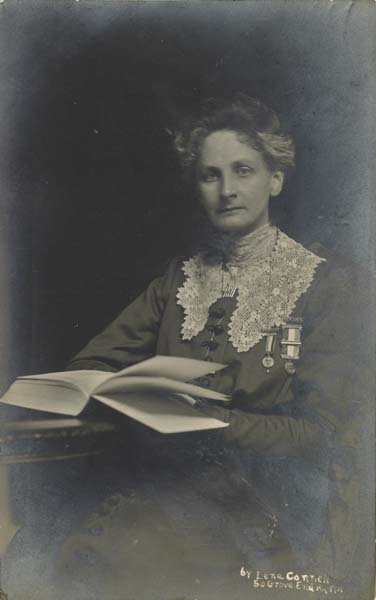Lady Constance Lytton, the daughter of Earl Robert Bulwer-Lytton, grew up in India where her father was Viceroy. She became a Suffragette after a youth spent suffering from a heart condition and romantic disappointment. Her mother had refused her permission, in 1892, to marry a Constance loved because of his lower social status. She refused to contemplate marrying anyone else, and became acquainted with the women's suffrage movement via her sister Betty and her husband Gerald Balfour, a supporter of votes for women.
She became ever more supportive of the Suffragettes, despite initial disagreement with militant tactics. In a letter to Adela Smith on 8 September 1906 she wrote: "They (the suffragettes) have come into personal first-hand contact with prison abuses. My hobby of prison reform has thereby taken on new vigour… I intend to interview the female inspector of Holloway prison, and will take part in the Suffragette breakfast with the next batch of released Suffrage prisoners on September 16."
Constance joined the WSPU in January 1909 and just one month later was sentenced to a month in Holloway for taking part in a deputation. She spent most of her sentence in the hospital ward, aware she was being accorded special treatment due to her aristocratic background and known heart condition. Arrested a second time in October 1909 for throwing a stone at a car she believed was carrying Lloyd George, Constance returned to prison and immediately went on hunger strike.
On again being released early she resolved to disguise herself in future as a working class Suffragette. Whilst working in Liverpool during the WSPU's general election campaign in January 1910 Constance was arrested using the disguise of a working girl 'Jane Warton.'
Sentenced to two weeks in prison with no special privileges she went on hunger strike and was force-fed. Her contrasting treatment sparked fury amongst the leadership. On her release Constance became a paid organiser of the WSPU. Despite suffering a stroke in 1911, Constance took part in the window smashing campaign and returned to Holloway, although quickly released on anonymous payment of her fine. Following a second stroke in 1912 Constance was unable to resume an active role in the militant campaign.
She concentrated thereafter on writing articles and pamphlets for the WSPU, releasing a book in 1914 called Prisons and Prisoners. After the success of the Suffragette campaign for votes for women, Constance supported Marie Stopes and her campaign for access to birth control.








